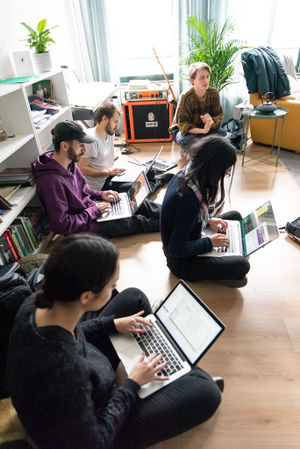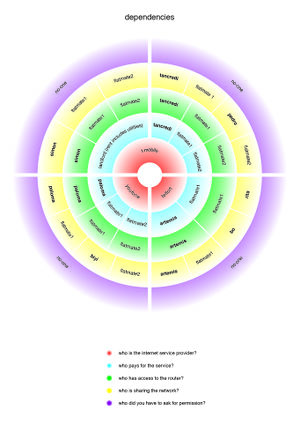Homebrewserver infrastructour
Mapping of dependencies, a visualization task
1. who is the internet provider?
2. who pays for the internet?
3. who has access to the router?
4. who is sharing the network?
5. whom did you have to ask permission?
artemis (ag), rita (rg), bo (bw)
1. telfort (KPN network)
2. ag, flatmate1
3. ag, flatmate1
4. ag, flatmate1, rg, bw
5. no-one
simon (sb)
1. t-mobile
2. the landlord (utilities are included in rent)
3. sb, flatmate1, flatmate2
4, sb, flatmate1, flatmate2
5. no-one
paloma (pg), biyi (bw)
1. Youfone (KPN network)
2. pg, flatmate1, flatmate2
3. pg, flatmate1, flatmate2
4. pg, flatmate1, flatmate2, bw
5. no-one
tancredi (tdg), pedro (psc)
1. t-mobile
2. tdg, flatmate1, flatmate2
3. tdg, flatmate1, flatmate2
4. tdg, flatmate1, flatmate2, psc
5. no-one
Visualisation
sb, wm and wr depend on their internet connection
sb, wm and wr depend on a paid service to t-mobile
connection to this service depends on a router owned by t-mobile
the router depends on an underground cable to t-mobile’s network
t-mobile’s network depends on interconnected underground cables throughout the netherlands
rg and bw depend on ag and hv/dg’s internet connection
ag and hv/dg depend on a paid service to telfort
connection to this service depends on a router owned by telfort
the router depends on an underground cable to telfort’s network
telfort’s network depends on a connection to kpn’s network
kpn’s network depends on interconnected underground cables throughout the netherlands
Stories/anecdotes
We understood from the start that would be impossible to do everything by ourselves and therefore this process wouldn’t be individual. We had some preconditions, e.g having access to our home routers, but these needs really went beyond the software. In some cases, we had to rely on other person’s router (and goodwill) to host our own server, so slowly we started to build our interdependencies.
- pedro, rita, bo, biyi depend on others - can't use their home router/internet connection for servers
biyis anecdote for paloma's router?
- paloma has all the infrastructures in one place (internet, water, gas....)
- tancredi has the router at the 2nd floor but the plug for the ethernet cable is at the ground floor
other stories:
* The story of the Chinese provider VS past US hegemony in the sector * Some of the ethernet ports are only for TV and others only for internet, so not all of them can be used * On the Tmobile router if you are connected in the same connection with the pi you can't access with the external IP (both from browser and SSH), you need to connect in LAN * There is the possibility that to set a fixed IP is not possible or it is already done in the default settings * On the Tmobile router there is a usb port where is possible to attach
Artemis — in order to have access to the router, we all had to know the routers’ passwords. In some cases, the passwords were left unchanged/default.
We traced the route with traceroute (“traceroute is a network tool used to show the route taken by packets across an IP network.”) As the result, we can have very different paths because there is not a unique path.
We can check where is the IP with geoiplookup (“an online tool anyone can use to get accurate IP address information”).
We changed the firewall settings to make it public and also to enable exterior connection to the pi (through shh). We had to open 3 ports.
We also established a static IP address. (LAN — DHCP)
Paloma — the router was in an interesting place, behind a door, it had a room for itself.
The network company (ZTE) brought up some stories about American access to networks, the relationship between the US and China, America banning Chinese equipment, etc.
Biyi sent an article about this:
https://mbd.baidu.com/newspage/data/landingsuper?context=%7B%22nid%22:%22news_10206595552637159544%22%7D&n_type=0&p_from=1
It was also discussed port forwarding (having two people with the same host). Biyi opened her ports here for her raspberry pi. We talked about OpenWrt Project (“Instead of trying to create a single, static firmware, OpenWrt provides a fully writable filesystem with package management”)
Bo — here we encountered a problem, the building had some kind of security and it was impossible to manage the ports. We discussed the possibility of tunneling.
Simon — it was discussed the better option for the ones without access to their own routers (bo, rita, biyi, pedro): to share a server or to share a machine/raspberry pi. The downside of sharing a server would be having to write the domain name and adding the port name. (eg. website.com:2009) For now, we decided to go for this option. When opening the port for web servers, Simon had to exit the local network to test the connection (couldn't do it over the local network). On both Simon's and Tancredi's routers, only two of the four ethernet ports were for Internet (labelled INT).
Tancredi — In the last house that we visited we had a problem, there weren’t enough ports to host the 4 pi’s left. This router had some ports specifically for tv and others. We understood that these ports don’t work for our purposes.
Some new terms: [added to the jargon pad]
https://pad.xpub.nl/p/jargon-file
- LAN
- WAN (wide area network)
- subnet mask
- gateway (router of the router, a network of networks, a machine where all the data travels through)
- mirroring (pirating but also for political reasons, see the case with Turkish Wikipedia)
- pi hole (add blocking)
- dropping (ignoring)


